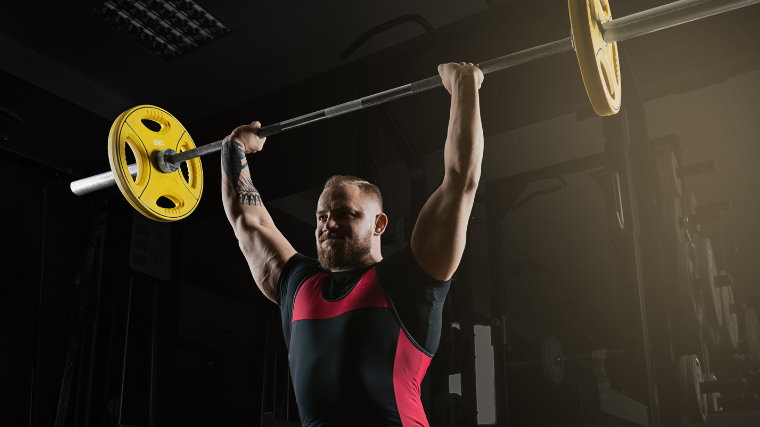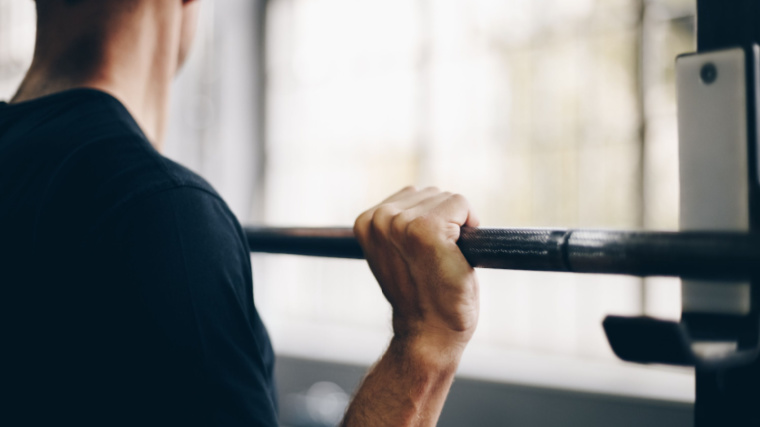The overhead press sometimes flies under the radar and its reputation is eclipsed by lifts like the bench press. However, a big overhead press can turn as many (if not more) heads in your gym. Your shoulder is the most mobile joint in your body — you need to take it seriously and respect the overhead press if you want to reap the benefits.
The overhead pressing motion can tell you a lot about what’s happening in your surrounding musculature, from lat tightness to poor scapular control. By addressing limitations, programming properly, and executing the movement efficiently, you can safely train the overhead press and build those boulder shoulders.

Before you rush to throw that barbell over your head, make sure you don’t have any glaring issues that restrict and disrupt your rhythm. If you’re committed to pressing like a pro, avoid these five common mistakes:
Common Overhead Press Mistakes
Lack of Preparation
You need to make sure you can tolerate the overhead position in the first place. If your shoulder flexion is limited and your scapula dances all over the place as you raise your arm, you probably aren’t prepared for load. Use these assessments and drills to highlight and address any mobility or stability issues.
How to Fix It
Assess, don’t guess. If you’re going to press overhead, you want to be able to do it safely and effectively. Rather than jumping right in, assess your shoulder joint first.
To make sure you can tolerate a load overhead, you should be able to demonstrate pain-free, unloaded shoulder flexion and not have any glaring mobility issues. Go through some quick assessments such as the ones in the video below and make sure there are no limitations to your movement:
If the motion of shoulder flexion doesn’t sit well with you, there are a few exercises that are a bit more shoulder-friendly and will still hit your deltoids. For example, you can substitute the standard barbell press for a neutral-grip landmine press. It’s generally the same motion, but demands less of your overhead and wrist mobility:
You might find that you can get yourself into a reliable overhead posture, but it takes a good deal of warming up. To improve your shoulder stability or mobility, incorporate some drills into your warm-up and see if it improves your overhead assessment:
If necessary, you can include unilateral overhead pressing exercises before you jump into the barbell press. Whether it’s a single-arm dumbbell overhead press, or a single-arm landmine press, try to balance out any glaring asymmetries before you get to the barbell.
Grip Placement
Where you grip the bar will impact how the movement is executed. Too much extension of the wrist, or an excessively wide grip, can lead to issues up the chain. However, your grip placement needs to mesh with your own personal structure and comfort as well.
How to Fix It
Grip the bar with your hands slightly outside of shoulder width. This tends to be the most friendly to the shoulder joint and leads to a consistent bar path. If your elbows are flaring out, you may be losing lat involvement, disrupting your stacked upper body positioning, or limiting power output.
To improve your positioning, bring your hands in slightly and lock your wrists in place. While a wider grip might shorten your bar path, it also makes it more difficult to keep the elbows in and your core snugly braced.

To keep your elbows from flaring, retract your shoulder blades slightly, keep a big chest, and think about squeezing something in your armpit as you initiate the press. This allows you to maintain a stable base to press safely from.
Losing Your Brace
If you are going to perform the standing version of the overhead press, you need to pay attention to your brace. If you lean excessively or start letting your ribs flare, you may open yourself up to potential issues in your back, hip, or shoulder.
While the leaning press is a staple of old-time strength competitions, it’s an extreme technique that is best reserved for professional strength athletes. If you train recreationally, keep your spine rigid.
How to Fix It
Keep your ribs packed and abs tight. Your ability to maintain a stacked upper body pillar will optimize your brace and improve your overhead press. If you aren’t packing your ribs, you may lose out on the stability provided by engaging your entire core.
To improve your “pillar”, you need to lock your ribs down and hone in on your breathing. You should have an understanding of how to breathe into your belly and create intra-abdominal stiffness. Your core serves as the anchor that allows a safe and effective transfer of force while you press.
To maintain enough stiffness, don’t forget about your feet. You want to root into the floor and activate your lower body isometrically. Tightness anywhere is tightness everywhere. If your legs aren’t actively involved, you can lose your base and start leaking energy. Think about gripping the floor with your feet and creating tension in the glutes and quadriceps.
Sloppy Bar Path
The shortest distance between two points is a straight line. If your bar path is sloppy and inconsistent, you can’t effectively hit the target muscles and risk shifting tension to other areas. Make sure your bar path is efficient and consistent to optimize your pressing goals.
How to Fix It
The best way to self-assess bar path is to film yourself performing the exercise from the side. The mirror can be helpful, but it also might distract you from putting in the necessary effort. A video (or feedback from a qualified coach or trainer) can help identify any potential restrictions affecting how your bar moves.
To improve your bar path, barring any physiological issues, you need consistent practice reps with a tight emphasis on the correct technique. If your grip position is adequate, ribs are packed, abs braced, and head is moving properly, your bar path should follow suit.
If your range of motion is affecting your bar path, you can add some mobility and stability drills into your warm-up. Take care to not push yourself too hard or implement a drill that may cause or exacerbate pain.
Improper Head Movement
One of the most common mistakes you’ll see during the overhead press is improper head movement. If you fail to move your head backwards during the press, or don’t move it forward to complete the rep, you’re liable to disrupt your bar path, constrict your range of motion, or put you at a mechanical disadvantage.
How to Fix It
The best way to learn a new skill is by actually doing it. Use a PVC pipe or a very light load and practice proper head movement. If you can’t do it without a load, you likely aren’t ready to add weight.
To make sure you’re moving your head properly, as you begin to initiate the press, you want to move your head backwards so you create room for the bar to go straight up. If you have to arc the bar up and around your face, you’ll lose power and stability.
To make sure you’re finishing the rep properly, bring your head forward as you lock out your elbows. This allows you to keep the bar close to your center of gravity, improve stability, and train a full range of motion.
If you don’t fully bring your head through, the bar’s anterior (or forward) position will severely limit your power output. As you bring the bar down, move your head back into the starting position.
Benefits of the Overhead Press
Once you’ve earned yourself a good overhead press and have a comprehensive understanding of what not to do, the benefits the exercise provides are just about endless. You can build muscle, improve your upper body strength, and even enhance your flexibility.
Increased Strength
Your shoulders are actively involved in most of your favorite upper body exercises, from the bench press to pull-ups. The overhead press will build serious strength in your deltoids, traps, and triceps. If you find your bench press is stuck, it might be time to add the overhead press and build up some of your weaknesses.
Hypertrophy
Who doesn’t want bigger, rounder deltoids? A broad pair of shoulders improves the appearance of your physique and helps make your waist look smaller. If you want to maximize hypertrophy, you need to work each muscle through a full range of motion and progressively load up on weight.
The overhead press allows you to use heavier weights than shoulder isolation movements like the lateral raise, and is easy to progress with in a linear fashion.
Improved Mobility and Stability
Trying to move into an overhead position can expose some mobility and stability issues in the shoulder joint. Quality overhead pressing is an effective tool to teach bracing, packing, and control in that range of motion. As you build strength in this range, it will likely enhance the mobility of your shoulder joint as well.
How to Overhead Press
Knowing what not to do is all well and good, but it won’t get you anywhere if you’re still learning the ropes in the first place. Luckily, the overhead press is a fairly straightforward movement if you approach it properly.
Step 1 — Shelf the Bar
Address a barbell that is sitting at roughly mid-chest height in a rack. Grab it at a shoulder-width grip to start, sweep your elbows down, and pull your upper chest to the bar. With the barbell resting firmly on your clavicles (but not pressing into your windpipe), perform a high partial squat to remove it from the rack.
Stand with your feet under your hips or slightly wider. The bar should sit comfortably in the space between your neck and the meat of your front deltoids. Your elbows should be down, but pointed forward enough that the bar doesn’t slide down your chest.
Step 2 — Brace and Push
Take a belly breath, tilt your head backward slightly, and drive the bar off your chest. Your head absolutely must move backward as you press so the barbell may travel in a straight line. As the bar leaves your body, actively push your feet down into the floor and squeeze your glutes.
Once the bar has cleared your head, pull your head back through to a neutral posture and lock your elbows out above.
Step 3 — Lower Slowly
Reverse the pressing motion to return the barbell to your body. As you lower it, once again pull your head out of the way of the barbell. You can gently bend your knees as the bar comes into contact with your clavicles to absorb some of the force if needed.
Wrapping Up
When done properly, the overhead press is one of the best bang-for-your-buck exercises. From muscle-building to mobility, there’s many ways to implement this exercise into your routine — and just as many benefits on offer.
However, if you want to build superhero shoulders, you need to press properly. Avoid these five potential errors and you’ll be on your way to bigger, stronger, beefier shoulders before you know it.
Featured Image: Andy Gin / Shutterstock